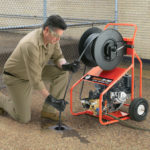Now is the perfect time to give your drain cleaning equipment a look over to make sure it’s all in good working order. Regular preventative maintenance should be performed to avoid problems. Here is a general maintenance checklist for your drain equipment:
- Check for damaged power cords, pulled out strain reliefs, damaged switches and missing ground prongs. Repair or replace if necessary.
- Check the drum belt for wear and replace any missing belt guards. Safety should be your first concern.
- Inspect the drain cable for kinks or damage. Repair or replace as needed.
- Oil the cable. A lubricated cable will last longer and slide though the feed easier.
- Inspect and clean the power cable feed. Replace feed rollers if they do not turn freely.
- Expose, clean and lubricate all bushings, bearings and moving parts (this should be done at least twice a year.) A well-lubricated machine will last longer and is less likely to break down in the middle of a job.
Taking care of your drain cleaning equipment protects your investment and avoids many headaches down the road. Be sure to follow all the recommended maintenance specific to your drain equipment that may not be on this list and always wear safety gear, including leather gloves, when using your drain cleaning machine. Regular maintenance ensures your plumbing equipment performs at its best, so make it a priority to keep it in top condition.
Go the Extra Mile
Since your equipment is your livelihood, treating it right is the most important thing you can do to prevent mishaps. Taking preventative measures in caring for your tools means fewer breakdowns, smoother jobs, and a longer service life. Keep your gear in top shape as the busy season ramps up:
- Keep It Clean, Inside and Out
Dirt, grease, and debris accelerate wear and hide issues. After each job, wipe down your machines, clear out drum housings, and make sure ventilation slots on motor housings are free of blockages. A clean machine is easier to inspect and safer to operate. - Inspect Camera Equipment and Locators
If you use a sewer camera system or pipe locator, check for cracked lenses, frayed cable sheathing, and any connection issues. Don’t wait for a fuzzy image or lost signal on a job site to discover there’s a problem. Wipe down the pushrod and clean off debris that might have built up on the reel. - Double-Check Jetters and Nozzles
For water jetters, flush the unit with clean water after each use and inspect nozzles for blockages or wear. A partially clogged nozzle can put extra strain on your pump and reduce cleaning efficiency. Make sure hoses are properly coiled and free from cracks or bulges, especially near the fittings. - Use the Right Lubricants
For cables, we recommend a high-quality cable oil specifically designed to resist rust and corrosion. Avoid household lubricants or anything that could break down under heat or moisture. - Replace Worn Parts Before They Fail
It’s tempting to run a feed roller or cutting head “just one more job,” but those extra jobs often come with a cost. If a component looks borderline, swap it out before you’re dealing with a failure in the middle of a tight schedule. Keep spare parts on hand so you’re not left scrambling. - Store Equipment The Smart Way
Between jobs or during downtime, don’t let your equipment sit in a damp truck bed or out in the elements. Store machines and cables in a dry, sheltered space. If moisture gets into a machine, it can lead to rust, corrosion, or electrical issues— problems that are easily avoided with proper storage.
Trust the Tools That Built the Trade
We’ve been helping plumbing pros keep their gear running smoothly for nearly a century. We’ve been around long enough to know that routine maintenance is your best defense against costly downtime.
And when the time comes for a replacement part, or a new tool altogether, you can trust General Pipe Cleaners to deliver the same durability and performance plumbers have relied on for countless jobs.
Need Tips?
Reach out to our team for specific inquiries, and we’ll be happy to help.



